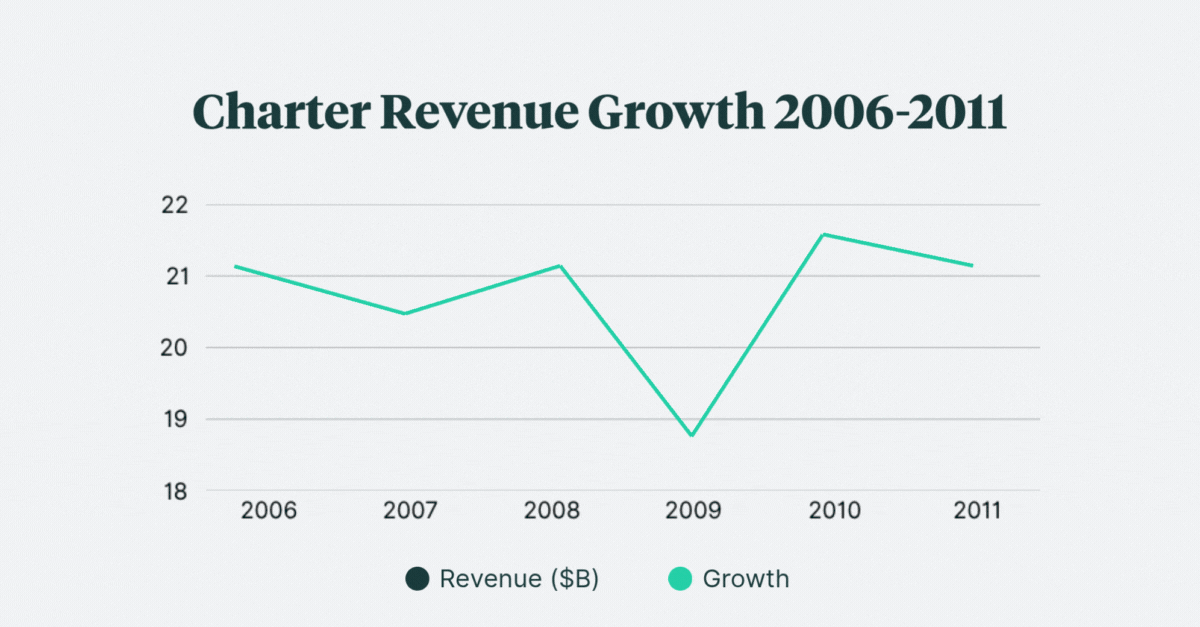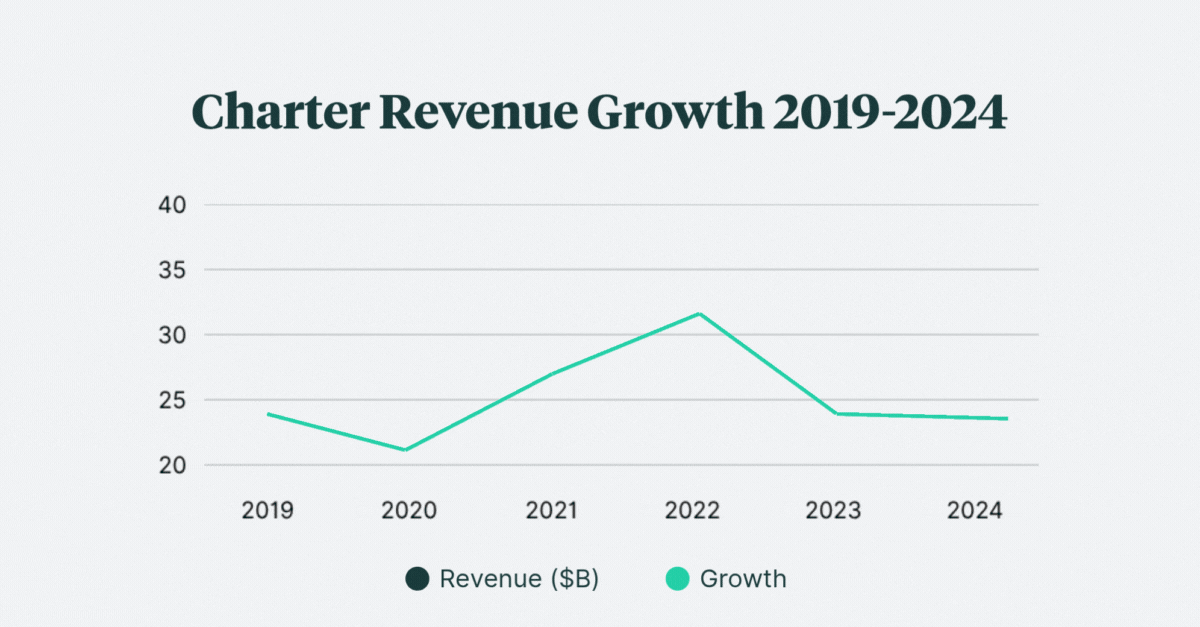A Strategic Analysis of Industry Evolution, Broker Emergence, and the Technology Advantage
The Bottom Line: While 2025's economic signals echo 2008, the charter aviation industry is writing a completely different story. Instead of contraction, we're witnessing expansion. Instead of consolidation, we're seeing specialization. And at the center of this transformation? Charter brokers have evolved from simple matchmakers to the critical infrastructure powering a $36.9 billion industry.
The numbers tell the story: revenue growing despite macro headwinds, employment up 52% since 2009, and profit margins nearly doubling pre-COVID levels. More importantly, roughly one third of charter flights are now brokered, up from 20% a decade ago representing a fundamental shift in how private aviation operates.
The technology advantage is real: Brokers leveraging platforms like Goodwin are converting more requests into bookings while completing the entire process, from initial request to confirmed booking, in just 9 minutes. In a market where every operational hour reclaimed translates to 40% more selling time, the brokers who embrace operational automation aren't just surviving this pivot, they're capturing disproportionate growth while their competitors remain buried in backoffice work.
From Crisis to Catalyst: The 2008 Parallel That Wasn't

At first glance, 2025 shares uncomfortable echoes with 2008: economic volatility, fiscal tightening, and uncertain global signals. The parallels seem obvious—until you examine what's actually happening in charter aviation.
The 2008-2009 Reality Check:
- Charter aviation revenue fell 7% as corporations slashed discretionary travel
- Flight hours declined 19.3% year-over-year
- Operators consolidated rapidly as demand evaporated
- The industry went into survival mode

The 2025 Reality:
- Revenue reached $36.9 billion in 2024 despite macro headwinds
- Employment has surged 52% since 2009
- Enterprise count approaches all time highs
- Profit margins have increased to 7.5% - nearly double pre-COVID averages
This isn't a bounce back. It's a fundamental rebalancing of who flies, why they fly, and how the industry serves them. The corporate executives making headlines for flying commercial in 2008 have been replaced by a more diverse customer base that views private aviation not as luxury, but as essential infrastructure.
The Great Perception Shift: From Wasteful to Essential
Remember 2008? GM's CEO famously drove from Detroit to Washington to demonstrate fiscal responsibility after initially flying private to congressional hearings. The optics were toxic and private aviation became synonymous with corporate excess and tone-deaf leadership.
Fast forward to today, and the narrative has completely flipped. Private aviation is increasingly viewed as:
Strategic Infrastructure: Companies recognize time savings and scheduling flexibility as competitive advantages, not perks.
Safety Protocol: Post-pandemic, controlled travel environments became risk management, not luxury.
Productivity Multiplier: The ability to conduct confidential meetings while traveling, access remote locations, and maintain packed schedules justifies the investment.
Operational Necessity: For companies with distributed teams, remote facilities, or time sensitive operations, private aviation has evolved from "nice to have" to "essential to compete."
The stigma hasn't disappeared entirely, but it's been overwhelmed by demonstrated value. Today's private aviation users are less concerned about perception and more focused on performance.
Brokers: From Matchmakers to Mission Control
Amid this industry transformation, charter brokers have emerged as the critical layer between evolving client demand and operator supply. A decade ago, brokers were essentially matchmakers connecting clients with available aircraft through relationships and rolodexes.
Today's successful brokers function as comprehensive aviation partners:
Logistics Managers: Coordinating complex multi-leg trips, ground transportation, catering, and crew scheduling.
Safety Consultants: Vetting operators, ensuring compliance, and maintaining safety standards that often exceed regulatory requirements.
Pricing Analysts: Leveraging market data and relationship insights to optimize costs while ensuring operator profitability.
Brand Stewards: Providing whiteglove service that reflects positively on their clients' reputations and values.
The numbers reflect this evolution. Roughly one third of charter flights are now brokered, up from 20% a decade ago, with that share steadily increasing. The average broker manages millions in flight spending annually, and top brokers differentiate through technology adoption, client experience excellence, and operational speed—not just access to aircraft.
But here's the operational reality: most brokers remain buried in back-office work. Manual quote generation, compliance documentation, payment processing, and trip reconciliation consume hours that could be spent building relationships and closing deals.
That's where the opportunity lies.
The Economics of Focused Selling
The broker driven segment of private aviation is experiencing remarkable expansion. Current market data reveals compelling growth trajectories:
Market Scale: The air charter broker market reached $36 billion in 2024 and some estimates project it to $49 billion by 2033, representing a robust 3.2% compound annual growth rate.
Geographic Concentration: North America represents approximately two-thirds of global business aviation activity, indicating substantial regional opportunity concentration.

Penetration Opportunity: With brokers currently serving about 31% of charter bookings, a significant 69% remains untapped for further growth.
Activity Trends: Global private flight activity continues expanding. North American activity finished the first half of 2025 up 1.7% compared to 2024, while other regions demonstrated even stronger growth at 18.9% year-over-year.
Flight Volume Growth: Departures increased 5% year-over-year, with charter segments rising 2.0% and fractional ownership up 7.9%.
The mathematics become compelling when viewed through a broker's lens:
At approximately 5 million private flights annually, every 0.1% shift toward brokered services represents 5,000 additional bookings. With typical broker commission rates around 7%, each marginal flight carries significant value. More critically, automation and backoffice support can free up to 40% additional selling time, enabling brokers to pursue new accounts, drive referrals, and cultivate existing relationships.
The Strategic Takeaway: With abundant growth opportunities available, brokers who reclaim operational time and focus on client development can capture disproportionate market share and drive substantial revenue growth.
Technology as the Great Enabler
The most successful brokers in today's market share a common characteristic: they've embraced technology not as a replacement for relationship building, but as an amplifier of their core competencies.
Consider the operational reality facing most brokers:
- Manual quote generation consuming hours per request
- Fragmented communication across multiple platforms
- Complex compliance documentation requirements
- Cumbersome payment processing and reconciliation
- Time intensive trip management and coordination
Every hour spent on these operational necessities represents an hour not invested in the activities that actually grow the business: building relationships, understanding client needs, and closing deals.
This is precisely where Goodwin delivers transformational value. We're not building another marketplace or attempting to disintermediate the broker-client relationship. Instead, we're constructing the infrastructure underneath while handling operational complexity so brokers can focus on what they do best: selling.
The Goodwin Advantage: Powering Broker Success
Goodwin exists to unlock broker growth by removing operational friction. Our platform addresses the core challenges that prevent brokers from maximizing their client facing time:
Speed and Efficiency:
- Trip request to booking completion in 9 minutes
- One in five trip requests convert to confirmed bookings
- Integrated sourcing across extensive operator networks
Comprehensive Integration:
- Unified platform handling sourcing, pricing, invoicing, and payment processing
- Seamless workflow eliminating platform switching and data reentry
- Real time market insights and pricing optimization
Brand Protection:
- Fully white labeled platform ensuring brokers remain the client facing heroes
- Customizable interface reflecting broker brand identity and values
- Behind the scenes efficiency without compromising relationship ownership
Operational Excellence:
- Automated compliance documentation and safety verification
- Streamlined communication protocols reducing client response time
- Comprehensive trip management from initial inquiry through post-flight reconciliation
The value proposition becomes clear: in a margin-driven business, operational efficiency isn't optional…it's everything. Every process improvement, every minute saved, and every workflow optimization directly translates to increased capacity for revenue-generating activities.
What Comes Next: Specialization and Scale
Private aviation isn't just scaling, it's specializing. As consumer expectations evolve and market sophistication increases, successful brokers will differentiate through speed, personalization, and trust rather than simple access to aircraft.
The Winning Formula:
- Less time on paperwork and administrative tasks
- Reduced platform switching and manual data entry
- More face time with clients and prospects
- Enhanced focus on relationship building and account development
Market Dynamics Favoring Prepared Brokers:
- Increasing client sophistication demanding higher service levels
- Growing emphasis on safety, compliance, and operational transparency
- Rising expectations for technology-enabled convenience and communication
- Expanding market reach requiring scalable operational capabilities
The brokers who recognize this shift and position themselves accordingly will capture disproportionate growth in an expanding market. Those who remain tethered to manual processes and operational inefficiencies will find themselves increasingly disadvantaged.
Conclusion: This Is the Pivot Point
This isn't 2008 redux. We're not witnessing a downturn—we're experiencing an evolution. The charter aviation industry is ascending into a future defined by new user demographics, innovative service models, and a fundamentally different type of broker.
The modern charter broker functions as aviation consultant, logistics coordinator, and trusted advisor. They leverage technology to amplify their core competencies while maintaining the personal relationships that drive long-term success. They understand that in today's market, selling isn't just what brokers do best, it's what they can't afford not to prioritize.
With the right technology foundation like Goodwin in their operational cockpit these brokers can spend less time reacting to administrative demands and more time proactively growing their businesses.
The opportunity is substantial. The market is expanding. The question isn't whether this transformation will continue, but which brokers will position themselves to lead it.
The future belongs to brokers who understand that operational excellence enables relationship excellence. And relationship excellence drives everything else.
.png)
.png)

.png)